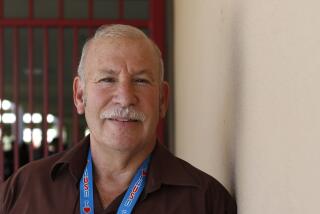Study in Contrasts
Hundreds of thousands of students in the Los Angeles Unified School District begin the 2000-01 school year today as administrators and teachers grapple with sweeping changes and surging enrollment in the nation’s second-largest school system.
Officially, the school year--and the changes--started in July for students at 220 of the area’s most crowded campuses, including 50 in the San Fernando Valley, operating on multitrack year-round schedules.
But for more than two-thirds of the district’s 723,000 students, officials said, today marks the beginning of a new era led by Supt. Roy Romer, the former governor of Colorado whom the Los Angeles Board of Education appointed in June to head Los Angeles Unified.
“You’re going to see some immediate changes for the better,” said Robert J. Collins, a superintendent heading one of the subdistricts created within the LAUSD under the reorganization that took effect July 1. The reorganization divided the sprawling district into 11 subdistricts, three of which are in the Valley, and is designed to give local leaders control over resources and the autonomy to make most decisions regarding money and staff.
Superintendents of the subdistricts also will be accountable for improving their students’ academic performance.
Principals and teachers in Collins’ District C, which comprises 67,849 students in an area roughly bisected by Ventura Boulevard, spent the week before the Labor Day holiday analyzing student achievement and determining how to improve it.
“We are not waiting for a five-year plan,” Collins said. “We’re figuring out how to improve student achievement now.”
*
Many also spent last week bracing for the projected 12,000 more students, bringing the LAUSD’s total enrollment to an all-time high.
“We’re trying to find space for the students,” said Stephen Lawler, principal at Portola Middle School, a 2,200-student campus in Tarzana.
Overcrowding is a districtwide crisis, prompting top officials to call for 210 schools to be built during the next six years.
In the Valley, where LAUSD officials broke ground last month on a new elementary campus in Van Nuys, the district plans to build 26 schools. Officials said many of those schools will be built within a mile-wide strip from Victory Boulevard to Lassen Street, east of the San Diego Freeway.
The rising student population has hit the Valley particularly hard as the economy has boomed and more families moved into the area after the 1994 Northridge earthquake. Adding to the crunch in classroom space is the district’s class size reduction program, which mandates a maximum student-teacher ratio in kindergarten through third grade of 20 to 1.
The district’s new retention policy--in which failing students in the second and eighth grades are held back--also poses a space problem for many schools, even those not immediately scheduled to go year-round. Those classes require a student-teacher ratio of 10-1.
At Portola, Lawler said he and his staff had to reconfigure classrooms to find additional space for the retained students. Some teachers will also have to stagger their schedules and share classrooms, he said.
“It is not good,” Lawler said. “We’ve tried to be creative and do the best we can, but when teachers have to share a classroom, it is not good for the students.”
Here’s how to contact the three San Fernando Valley subdistrict superintendents:
* Deborah L. Leidner heads District A, which includes 68,266 students and spans from El Camino Real High School in Woodland Hills to Monroe High in North Hills. Offices are at 8550 Balboa Blvd., Northridge. (818) 256-2814.
* Judy Ivie Burton heads District B, which includes 77,045 students in the East Valley. Offices are at 5200 Lankershim Blvd., North Hollywood. (818) 755-5300.
* Robert J. Collins leads District C, which includes 67,849 students in an area roughly bisected by Ventura Boulevard. Offices are at 6621 Balboa Blvd., Van Nuys. (818) 654-3600.
More to Read
Sign up for Essential California
The most important California stories and recommendations in your inbox every morning.
You may occasionally receive promotional content from the Los Angeles Times.










